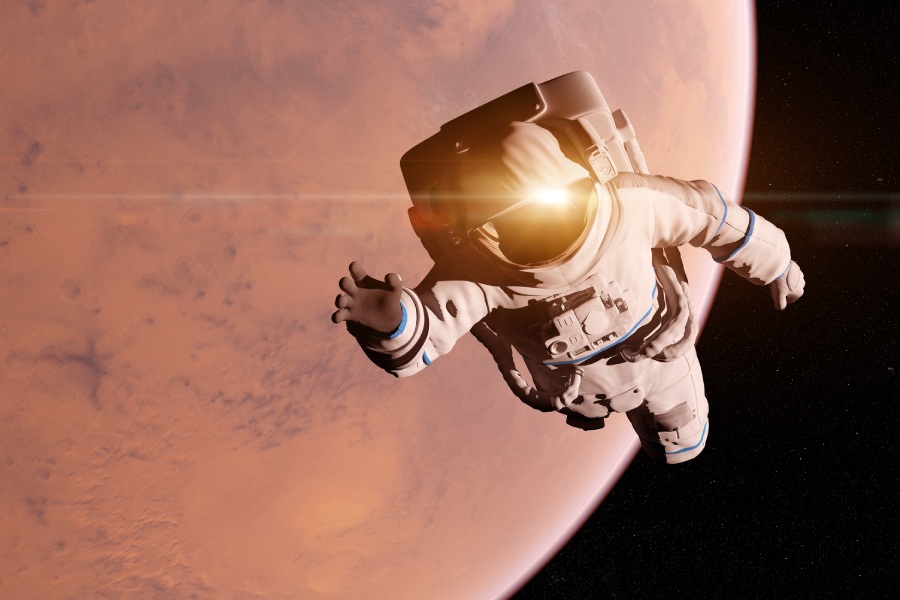Space exploration represents humanity’s quest to push the boundaries of knowledge and exploration beyond the confines of Earth. However, amidst the awe-inspiring vistas and scientific discoveries lie profound challenges for the human body. So, how long can you survive in space? Why does space have no oxygen?
In this article, we will explore the grim physiology of life and death in the vacuum of space. We’ll examine the experiences of accident victims exposed to vacuum conditions and see how long humans can remain conscious.
We’ll also discuss how air supply, decompression speed, and radiation impact survival time in the harsh space environment. Let’s get started and learn more!

How Long Can You Survive in Space?
Surviving in space without proper life support systems is impossible due to the lack of essential elements such as air, pressure, and temperature regulation. So, how long can you survive in space without a suit?
Without a spacesuit or a spacecraft with life support systems, an unprotected individual would not survive more than a minute in the harsh conditions of outer space. But can you breathe in space?
In the vacuum of space, there is no atmosphere to provide oxygen, and the absence of pressure might lead to bodily fluids boiling at body temperature. The extreme temperatures in space, alternating between extreme cold and heat, further pose significant risks.
Survival Duration in Space
Without a pressurized protective suit, humans would only survive for up to 30 seconds, fully exposed in the vacuum of space. Death would result from lack of oxygen, exposure, and decompression effects.
Reasons for the quick death in space
Does space have air? No, space is a vacuum, which means it’s mostly empty space between the planets and stars.
In the complete vacuum of space, the air in the lungs and prolonged lack of oxygen would prove fatal after roughly 15 seconds. Harmful space radiation begins penetrating the body immediately as Earth’s protective magnetosphere vanishes.
Decompression and temperature extremes
In space, extreme cold, decompression effects, and unshielded solar radiation bombard the body, rapidly compounding their impacts. Fluids in exposed soft tissues would boil, leading to cell damage, hypoxia, and heart failure, which combine to cause clinical death quickly without protective garments.
Contrary to what movies depict with instant freezing or explosive decompression, heat doesn’t immediately dissipate. Instead, a moderate expansion of water vapor temporarily shields the skin from the worst effects for up to 30 seconds.
However, if left unprotected, loss of consciousness and asphyxiation occur rapidly. Protective spacesuits address these issues by providing oxygen, pressure, temperature control, and radiation shielding.
Challenges of Sustaining Life
Space is an airless vacuum lacking the oxygen necessary for breathing and sustaining human life. Carrying self-contained oxygen or having spaceship life support is mandatory for survival in space.
Immediate exposure to vacuum
When exposed suddenly to the vacuum of space, gases trapped within the skin and tissues escape rapidly. This might lead to tissue damage or ruptured eardrums if the decompression is immediate. Additionally, any fluid on the tongue or eyes vaporizes instantly.
Within just 15 seconds, the lack of oxygen starts affecting the body’s functions, leading to impairment. Despite the body’s efforts to cope, survival becomes impossible. Death typically occurs within about a minute without proper protection.
Moreover, disorientation and loss of consciousness might happen in as little as 10 to 15 seconds due to a lack of oxygen reaching the lungs and brain. If not wearing a spacesuit, clinical death follows shortly after, usually within 30 to 90 seconds.
Effects of Lack of Oxygen and Atmospheric Pressure
Oxygen enables cellular respiration, producing energy needed to sustain life functions. Without breathing oxygen, organ damage and loss of consciousness start in less than 15 seconds. Death inevitably follows within minutes as tissues fail systemically without oxygen.
Impact of the absence of atmospheric pressure
What happens to the body in the absence of atmospheric pressure? Would you explode in space? In space, the scenario is different from what we might imagine.
However, internal organs undergo similar challenges. Without air in space, gases trapped in the lungs, sinuses, and stomach are forcefully released, causing harm to tissues. Lung tissues might bleed due to the strain of trying to inhale in the absence of air, while rapid decompression might lead to ruptures in the stomach and sinuses.
Structural problems may arise in the eardrums and air sacs within the body. The expansion of airways immediately dries out exposed membranes, leading to potential dangers. These injuries quickly lead to systemic hypoxia, a condition where the body lacks sufficient oxygen, and death could follow if not addressed promptly.
To counter these risks, astronauts rely on protective pressurized spacesuits. These suits supply breathable oxygen, effectively preventing the onset of systemic hypoxia and ensuring the astronauts’ safety in harsh space conditions.

Radiation Exposure
Sources of radiation
Space radiation comes from the Sun and cosmic rays beyond our Solar System. Solar storms and flares release energetic particles that might penetrate spaceships and protective suits.
Meanwhile, cosmic rays produce high-energy heavy nuclei particles when they collide with atmospheres. In space, radiation becomes more intense because there’s no Earth’s magnetic field to block it. The thin walls of spacecraft and suits offer minimal protection against this dangerous radiation.
Health risks
High levels of radiation increase the risk of cancer throughout life and harm DNA. Solar protons might penetrate the skin, causing burns. Vulnerable tissues include bone marrow, stomach, colon, and lungs. Also, serious risks such as cataracts, nervous system damage, or acute radiation sickness might arise.
In cases where intense solar flares deliver exceptionally high doses of radiation, dangerous acute radiation sickness can develop within hours or days. However, cancer and organ damage might take months or years to appear at lower, non-lethal doses. The total risk profiles for astronauts in space are determined by the duration of their mission and the levels of shielding they have.
Temperature Extremes
Extreme temperatures in space
Space lacks the kind of atmosphere that helps regulate temperature, creating what we call “heat islands” that aren’t ideal for life. This means there are huge temperature swings, going from extremely cold to scorching hot, spanning hundreds of degrees during each orbit around Earth.
On one side of an object in space, there’s direct sunlight, while the other side can be plunged into permanent darkness, which could cause freezing. This situation requires careful thermal designs for both long-duration space travelers and equipment. Without proper protection like climate-controlled spacesuits or vessels, humans would either freeze or overheat when exposed directly to space.
Effects on the human body
Without proper temperature control, the body may quickly develop hypothermia in cold environments, while prolonged exposure to intense heat might lead to hyperthermia. These extreme conditions might severely affect vital bodily functions.
Survivability in such conditions is possible for a short time, but prolonged exposure might lead to irreversible organ failure. The heart, brain, and circulatory system struggle to function normally under extreme temperatures, risking a complete collapse of bodily systems without intervention. The “time of useful consciousness” defines the small window of survivability in extreme temperatures.
The body can only withstand harsh circumstances for a few minutes before suffering a serious injury in the absence of protective gear or shelter. Without adequate protection, exposure to extreme cold might lead to instant freezing, while exposure to extreme heat may result in rapid dehydration and death.
Protective Measures and Survival Equipment
Importance of spacesuits and spacecraft
Special protective spacesuits and spacecraft enable survival in space’s harsh environment. These suits and vessels provide breathable oxygen at the necessary air pressures while regulating body temperatures and shielding against harmful radiation fluxes.
Without these essential components, the fragile human body is left vulnerable to rapid demise in the unforgiving vacuum of space. As mentioned before, without proper protective barriers, the human body is left extremely exposed to the dangers of space.
Duration of survival with protection
Spacecraft and space suit life support systems, with sufficient provisions, can keep astronauts safe for long periods. These systems shield them from the dangers of space, like vacuum and radiation.
For instance, astronauts can stay on the International Space Station for months, thanks to its climate-controlled and radiation-shielded environment. In the future, spacecraft will enable journeys lasting years for interplanetary travel and exploration of planet surfaces. Inside these vessels, away from direct exposure to space, the focus shifts from immediate threats to more familiar health concerns similar to those on Earth.
Conclusion
How long can you survive in space? The harsh environment of outer space presents formidable challenges to human survival, including the absence of essential elements like oxygen, extreme temperatures, and radiation exposure. Without proper protection, the human body can endure only for a brief moment before succumbing to unforgiving conditions.
However, humans can extend their presence in space for prolonged periods through technological advancements, such as protective spacesuits and spacecraft life support systems. These innovations pave the way for exciting possibilities in space exploration, enabling astronauts to undertake long-duration missions and delve deeper into the mysteries of the cosmos.
